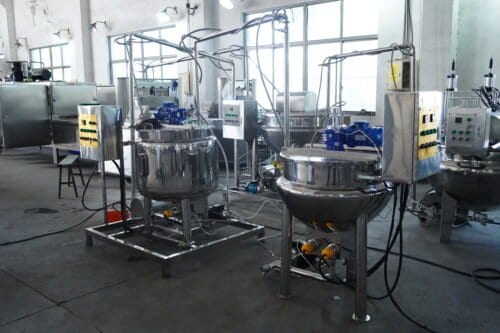
Thermoforming Blister Packaging Machine – Definition, Types, How It Works, and Why You Need One!

Exploring the Versatility of Gummy Candy Production Lines: What Products Can They Produce?
Which is more popular in the health care product market: gummies or compound tablets?
When it comes to health supplements, the method of delivery can significantly influence our perception of the product. What comes to mind when you see a pill or tablet? For many, it evokes a sense of seriousness, a reminder of illness, and the clinical act of taking medicine. Now, consider a gummy. It's colorful, soft, and sweet—more akin to a treat than a treatment. This contrast is precisely why gummies are gaining popularity over traditional tablets in the healthcare market.

In this blog, we will explore the science and strategy behind two popular forms of health supplements: gummies and tablets. What makes gummies appealing to consumers? How do tablets continue to maintain their relevance in the market? What are the trade-offs between these two formats, and why might a gummy candy production line, such as the SE-300, be essential for meeting modern consumer preferences? Let’s delve into these questions.
What Are Gummies and Tablets?
Gummies are soft, chewable supplements made from gelatin, pectin, or other gelling agents, combined with flavors, sweeteners, and active ingredients. Often colorful and shaped like fun forms such as bears or fruits, they are highly appealing to consumers of all ages.

Tablets, in contrast, are compact, solid-dose formulations made from compressed powders that contain active ingredients and excipients. They are commonly used for pharmaceuticals and dietary supplements because of their efficiency, stability, and cost-effectiveness.

Why Are Gummies Replacing Traditional Tablets?

Have you ever wondered why gummies are becoming more popular than tablets in the health and wellness industry? The answer lies in their appeal. Tablets often feel medicinal and impersonal, while gummies evoke a sense of fun, familiarity, and even indulgence. People tend to associate gummies with a treat rather than a treatment. This subtle difference in perception can significantly influence consumer behavior, particularly regarding dietary supplements and healthcare products.
How Do Gummies Compare to Tablets in the Healthcare Market?
Gummies and tablets both serve as delivery systems for active ingredients, but their differences extend beyond mere appearance. Tablets are compact, cost-effective, and easy to store, making them a staple in the pharmaceutical and supplement markets. However, they often have a bitter taste, which can deter compliance, particularly among children and individuals with swallowing difficulties.
Gummies, in contrast, provide a more enjoyable experience. Their chewy texture and sweet flavor make them an appealing choice for consumers of all ages. Furthermore, the variety of shapes and colors available for gummies adds an element of fun, which is especially effective in products targeted at children. However, there are some downsides: gummies typically have a shorter shelf life and are more sensitive to storage conditions such as temperature and humidity.
What Are the Key Advantages of Gummies?
Improved Consumer Compliance
The appealing taste and chewable texture of gummies make them easier to consume than traditional tablets. For individuals who have difficulty swallowing pills, gummies serve as a practical alternative.
Enhanced Customization
Gummies can be crafted in a variety of shapes, flavors, and colors, which not only enhances their visual appeal but also provides opportunities for branding and marketing.
Potential for Combination Formulations
Gummies enable manufacturers to combine multiple active ingredients into a single dose, including vitamins, minerals, and other supplements. This versatility is more challenging to achieve with tablets because of their compact size.
Consumer-Friendly Nutritional Delivery
The delightful flavor of gummies makes them an excellent choice for providing vitamins and nutrients to both children and adults who might otherwise be reluctant to take supplements.A Comprehensive Overview of the Gummy Manufacturing Process
Gummy production involves several precise steps to ensure quality and consistency.
Mixing and Heating
Ingredients such as gelatin, pectin, and carrageenan are combined with sweeteners, flavors, and active components. Heating is applied to achieve the appropriate consistency for molding.
Cooling

The mixture is poured into molds and allowed to cool until it sets. This step necessitates strict control of temperature and humidity to ensure product quality.
Auxiliary Equipment
-500x333.jpg)
Auxiliary equipment, including depositors, cooling tunnels, and packaging systems, is essential for scaling up production while maintaining consistency and quality.

What Challenges Do Gummies Face Compared to Tablets?
While gummies offer numerous benefits, they also present certain challenges.
Storage and Stability: Gummies are sensitive to heat and moisture, which can impact their texture and shelf life. Therefore, proper packaging and storage conditions are essential.
The caloric content of gummies often includes added sugars, which may not align with the dietary preferences of health-conscious consumers.
Production Costs: The manufacturing of gummies necessitates specialized equipment and involves more complex processes than that of tablets.
A Look at the Gummy Manufacturing Process
Mixing and Heating

Ingredients such as gelatin, pectin, and carrageenan are combined with sweeteners, flavors, and active components. Heating is applied to achieve the appropriate consistency for molding.
Molding and Cooling
-500x333.jpg)

The mixture is poured into molds and allowed to cool until it sets. This step necessitates strict control of temperature and humidity to ensure product quality.
Demolding and Coating

Once set, gummies are removed from molds. Some may be coated with sugar or oil for added texture and to prevent sticking.
Packaging

Gummies are typically packaged in airtight containers to preserve freshness and prevent contamination.
When Are Gummies the Better Choice?
Gummies are particularly well-suited for:
Children and the Elderly: Their chewable format makes them easier to consume for those who may struggle with tablets.

Multi-Nutrient Formulations: Gummies can accommodate multiple active ingredients, offering convenience to consumers.

Lifestyle-Oriented Products: Gummies’ fun and appealing nature aligns with wellness and lifestyle branding.
The growing popularity of gummy supplements over traditional tablets has been explored in various studies. Here are some key findings:
Consumer Preferences: Gummy supplements are increasingly favored by adults, not just children[1], due to their taste and ease of consumption.
Market Growth: The gummy supplements market is projected to reach $16.5 billion by 2028[2], indicating a significant shift in consumer preferences.
Bioavailability: Studies comparing vitamin D3 gummies[3] and tablets found that gummies had greater bioavailability, suggesting they may be more effective in certain cases.
Manufacturing Innovations: Recent advancements in gummy manufacturing [4]include the use of alternative gelling agents and natural sweeteners, catering to health-conscious consumers seeking natural and nutritious options.
These studies highlight the factors contributing to the increasing preference for gummy supplements over traditional tablets in the health supplement market.
Conclusion
Gummies and tablets each have their place in the healthcare and supplement industries. While tablets are practical and cost-effective, gummies offer a more consumer-friendly and enjoyable experience. Understanding the strengths and limitations of each format can help manufacturers and consumers make informed choices that align with their needs and preferences.
Reference
1.Krawiec, Sebastian. "Who’s Driving the Gummy Supplement Market? Hint: It’s Not Kids." Nutritional Outlook, vol. 21, no. 9, 31 Aug. 2018.Who’s driving the gummy supplement market? Hint: It’s not kids.
2.Lesina, Sara. "Nutraceutical Dosage Trends: Functional Gummies Offer Alternative to Tablets and Capsules." Contract Pharma, 10 Mar. 2023.Nutraceutical Dosage Trends: Functional Gummies Offer Alternative to Tablets and Capsules – Contract Pharma
3.Wagner, Carol L., et al. "Bioequivalence Studies of Vitamin D Gummies and Tablets in Healthy Adults: Results of a Cross-Over Study." Nutrients, vol. 11, no. 5, 7 May 2019, p. 1023, doi:10.3390/nu11051023. PMCID: PMC6566230.Bioequivalence Studies of Vitamin D Gummies and Tablets in Healthy Adults: Results of a Cross-Over Study - PMC
4.Tarahi, Mohammad, et al. "Current Innovations in the Development of Functional Gummy Candies." Foods, vol. 13, no. 1, 25 Dec. 2023, p. 76, doi:10.3390/foods13010076. PMCID: PMC10778822.Current Innovations in the Development of Functional Gummy Candies - PMC




